40 Actionable Photography Marketing Ideas Every Photographer Needs to Know to land more clients fast (2025)
Introduction: 40 Photography Marketing Ideas That Every Photographer Should Be Using
Alright, let’s jump into this photography marketing adventure and ignite explosive growth for your business! Whether you’re just starting or have been capturing moments for years, this guide is packed with strategies to level up your game. We’re not just skimming the surface with Instagram posts or flyers—we’re diving into proven tactics that truly move the needle.
From crafting a standout brand to mastering digital marketing, you’ll discover how to amplify your visibility, attract your ideal clients, and boost your revenue. Get ready, because your photography business is about to soar to new heights. Let’s get started!
Key Takeaways:
Key Financial Statistics about the Photography Industry:
Here are six significant financial statistics about the photography business industry:
These statistics highlight the substantial economic impact and growth potential within the photography industry.
Define Your Photography Niche:
Defining your photography niche is the foundation of your marketing strategy. A well-defined niche allows you to focus on a specific audience, tailor your marketing efforts, and establish yourself as an expert in your chosen field.
Whether you specialize in wedding photography, newborn portraits, real estate photography, or commercial shoots, having a clear niche sets you apart in a saturated market. Here’s why this step is crucial for your photography marketing success:
1. Targeted Marketing: When you define your niche, you can create highly targeted marketing campaigns that speak directly to the needs, desires, and pain points of your ideal clients. Instead of a broad and generalized message, your marketing will resonate with a specific group, making it more effective.
For instance, wedding photographers can focus on bridal magazines, wedding expos, and partnerships with wedding planners, while real estate photographers may target property developers and real estate agencies.
2. Brand Identity Alignment: Your niche influences your brand’s tone, visual style, and message. By narrowing your focus, you can build a cohesive brand identity that consistently appeals to your target market.
If you’re a family portrait photographer, your branding might emphasize warmth, emotion, and moments of connection, while a fashion photographer would focus on creativity, style, and high-end aesthetics. This clarity helps create a memorable brand that clients trust.
3. Expert Positioning: Specializing in a niche allows you to position yourself as an expert in that area, rather than a generalist. Clients are more likely to book a photographer who is seen as a go-to authority for their specific needs.
For example, a couple looking for a wedding photographer will prefer someone who has mastered that niche over a generalist. Expertise breeds trust, which leads to higher conversion rates and referrals.
4. Increased Pricing Power: Photographers with a well-defined niche often command higher prices. Specializing means you’ve honed your craft in that area, and clients are willing to pay a premium for your expertise.
When you focus on a niche, you’re able to offer tailored packages and services that align perfectly with your target audience’s needs, allowing you to charge accordingly.
5. Efficient Use of Resources: Knowing your niche helps you allocate your marketing resources more efficiently. You won’t waste time and money on platforms or strategies that don’t align with your audience.
For example, if you’re a product photographer, your efforts should focus on building relationships with eCommerce brands, attending trade shows, and leveraging platforms like LinkedIn for B2B networking, rather than advertising in wedding publications.
6. Build a Loyal Client Base: By focusing on a specific niche, you can create deeper connections with your clients, which fosters loyalty and repeat business. Specialized photographers tend to have a higher client retention rate because they serve a niche market that often requires ongoing services (e.g., newborn photography that evolves into family portraits).
A loyal client base also means more word-of-mouth referrals within that niche.
In summary, defining your photography niche isn’t just a smart business move—it’s essential for developing an effective and sustainable marketing strategy. It allows you to streamline your marketing efforts, position yourself as an expert, and attract high-quality clients who are willing to invest in your services.
With a clear niche, your marketing becomes more focused, your brand more defined, and your path to success much clearer.
Photography Marketing Plan:
Executive Summary:
The purpose of this marketing plan is to outline strategies to increase visibility, attract more clients, and grow revenue for a photography business.
The focus will be on establishing a strong brand presence both online and offline, targeting specific niches, and leveraging a combination of digital marketing and traditional methods to generate leads, improve client retention, and increase sales.
This is a general marketing plan. You can tweak this depending on your chosen photography niche.
Target Market:
The target market for the photography business includes individuals and businesses who need professional photography services in specific niches such as:
- Weddings and Events: Couples looking for wedding photography, event planners, and families for special occasions.
- Portrait Photography: Families, individuals, corporate professionals, and models requiring headshots or portrait sessions.
- Commercial Photography: Businesses needing product photography, corporate headshots, or real estate and architectural photography.
- Fine Art Collectors: Art buyers interested in purchasing unique, high-quality photography prints.
Ideal Customer:
The ideal customer profile for the photography business includes:
- Demographics: Age 25-45, predominantly middle to high-income, residing in urban or suburban areas.
- Behavioral Traits: Customers who value professionalism, creativity, and high-quality photography. They are likely to book services for memorable life events or to enhance their personal or business brand.
- Needs: High-quality photography for personal milestones (weddings, portraits) or business purposes (branding, product marketing).
Unique Selling Proposition (USP):
The photography business stands out due to its unique blend of artistic creativity, technical expertise, and personalized service. The business specializes in creating stunning visual stories that capture the essence of every event, product, or person.
With a focus on delivering a high-end, tailored experience, our attention to detail and ability to exceed client expectations set us apart in the market.
Marketing Objectives:
- Increase brand awareness by 30% in the next 12 months.
- Generate 25 new leads per month through targeted online marketing efforts.
- Increase client retention by 15% through personalized follow-ups and loyalty programs.
- Achieve a 20% increase in overall revenue within the next year.
Photography Marketing Strategies: (see here)
Performance Metrics:
To measure the effectiveness of the marketing strategies, the following key performance indicators (KPIs) will be tracked:
- Website Traffic: Monitor website visits, bounce rate, and lead conversions through Google Analytics.
- Lead Generation: Track the number of new leads generated through online forms, direct inquiries, and social media interactions.
- Client Retention Rate: Measure the percentage of clients who return for additional services or refer new clients.
- Conversion Rate: Track the percentage of inquiries that turn into bookings or sales.
- Return on Investment (ROI): Measure the revenue generated from specific marketing efforts compared to the costs.
This photography marketing plan outlines a comprehensive approach to growing the business by leveraging a mix of digital marketing, traditional outreach, and innovative techniques.
By focusing on a well-defined niche, building a strong online presence, and nurturing client relationships, the business can achieve its revenue and growth goals while creating lasting impressions in the minds of potential customers.
Through consistent efforts and measurable strategies, this plan will help the business succeed in a competitive market.
40 Best Photography Marketing Ideas For Photographers to Try:
A. Build a Strong Brand and Reputation:
1. Craft a Unique Brand Identity:
Your brand identity is the personality of your business. It’s how clients perceive you before they even meet you. Choose a memorable logo, a consistent color scheme, and a tone of voice that resonates with your audience. Every interaction—online or offline—should reflect this identity. Photography marketing plays a vital role in visually capturing and communicating this identity, ensuring it stays memorable and impactful.
Whether you’re edgy, sophisticated, or somewhere in between, your brand needs to stand out in a crowded market. Photography marketing starts with people remembering you, and a strong brand is the key to that.
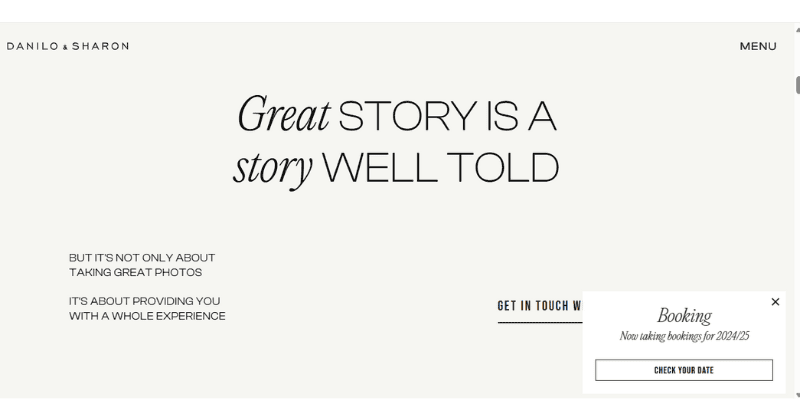

2. Showcase a Professional, High-Quality Portfolio:
Your portfolio is the face of your photography business—it’s the first thing potential clients will look at to assess your skills and style. Ensure it reflects your best work, focusing on the type of photography you specialize in, whether that’s portraits, weddings, commercials, or fine art.
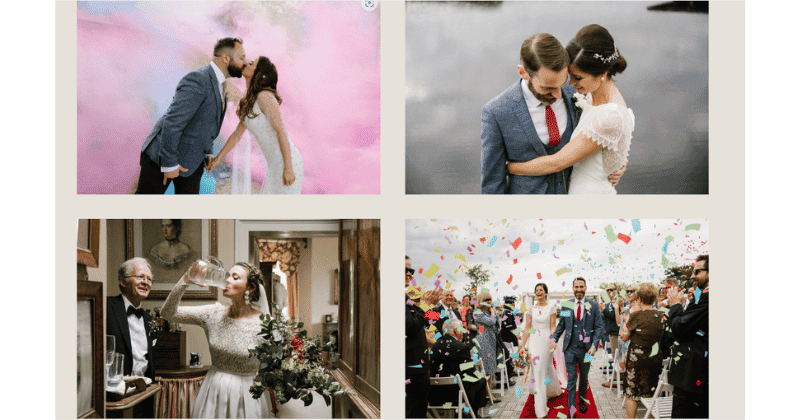

Showcase a diverse range of images that highlight your technical expertise and creativity, ensuring each photo tells a compelling story.


But don’t just stop there—update your portfolio regularly with recent projects to keep it fresh and relevant. Include behind-the-scenes shots or a short narrative explaining the context or challenges behind each session, which helps potential clients connect with your process.


A portfolio isn’t just a collection of images; it’s a carefully curated visual resume that conveys your unique approach and sets you apart from other photographers in your niche.


3. Gather Client Testimonials and Positive Reviews:
Client testimonials are social proof. They reassure potential clients that you deliver results. Ask happy clients for a quick review after every job and make sure to post them on your website and social media. Photography marketing can enhance these testimonials by visually showcasing your work alongside the client’s positive feedback, creating a more compelling story.
People trust the word of others more than your marketing materials. Testimonials don’t just boost your credibility; they humanize your business. The more authentic, the better. Make it part of your process to collect these gold nuggets of trust.


4. Maintain Consistent Branding Across All Platforms:
Consistency in branding builds trust. From your website to your Instagram posts, every touchpoint should reflect the same brand identity. This means using the same logo, colors, fonts, and tone of voice wherever people interact with you. If someone finds you on Facebook and then visits your website, they should immediately recognize your brand. Photography marketing can play a key role here by visually reinforcing your brand’s identity across platforms, ensuring that your message is consistent and cohesive.
Consistency isn’t just about looking good; it’s about creating a seamless experience that makes potential clients feel secure in hiring you. Consistency breeds credibility, and credibility turns into bookings.
5. Prioritize Exceptional Customer Satisfaction:
Customer satisfaction is your silent marketing tool. Satisfied clients will sing your praises, refer you to their friends, and leave glowing reviews. It’s not enough to just deliver great photos—you need to deliver a great experience. Treat your clients like gold from the first consultation to the final delivery. Photography marketing leverages this satisfaction by visually showcasing your best work and client experiences, amplifying your reputation and reach.
Be responsive, professional, and always over-deliver. Happy clients become repeat clients, and repeat clients are the foundation of a thriving business. Photography marketing starts with creating raving fans.
6. Implement a Client Referral Program:
A referral program incentivizes your happy clients to spread the word. Offer discounts or bonuses for every new client they refer. It’s simple and effective. People trust recommendations from friends and family, and a well-structured referral program can supercharge your word-of-mouth marketing.
Make the referral process easy, and remind your clients often. Think of it as your personal marketing army. Every happy client becomes a potential marketer for your business. The referral program is one of the best photography marketing ideas you can implement.
7. Launch a Customer Loyalty Program:
Loyalty programs are a great way to keep clients coming back. Whether it’s a discount after their fifth session or a free photo book for repeat business, rewarding loyalty ensures your clients stay engaged. Set clear milestones and offer tangible rewards.
It’s a small investment that can lead to long-term relationships. The more clients feel appreciated, the more they’ll stick with you. It’s easier to retain a client than to acquire a new one, so make it count. Customer retention is cheaper than new client acquisition. This is one of the best free photography marketing ideas you should maximize.
B. Master Digital Photography Marketing Strategies:
8. Design and Develop a Professional Photography Website:
Your website is your digital storefront. It’s often the first impression potential clients have of your business, so make sure it’s polished and professional. Invest in high-quality images, a clean layout, and easy navigation. Photography marketing can elevate your website by using compelling visuals that resonate with your audience and showcase your unique style.
Include your portfolio, pricing, and contact info, and make it mobile-friendly. Search engine optimization is essential, too—clients won’t hire you if they can’t find you. A well-designed website not only attracts clients but also converts them into bookings.
Pro Tip:
Leverage the Systeme.io website builder to create a stunning, photography website that showcases your portfolio, captures leads through integrated contact forms, and drives client bookings with high-converting landing pages.


9. Optimize Your Website for Search Engines (SEO):
SEO is the art of getting your website found. Start by researching the keywords your potential clients are searching for, like “wedding photographer in [your city].” Optimize your website content, meta tags, and images to rank for these terms. SEO takes time, but it’s worth the investment.
The higher you rank in search results, the more organic traffic—and potential clients—you’ll get. Combine this with local SEO tactics to dominate your area.
Pro Tip:
Leverage NeuronWriter to optimize your photography website’s content by researching high-ranking keywords, improving on-page SEO, and creating friendly blog posts that boost your visibility on search engines.


10. Engage in Content Marketing Strategy with a Photography Blog:
Blogging is an underrated marketing tool. It helps with SEO, positions you as an expert, and gives potential clients a deeper look into your style and personality. Write about photography tips, behind-the-scenes stories, or recent shoots in your blog posts. Keep your content relevant and engaging. Photography marketing can enhance your blog by using captivating images that draw readers in and visually tell the story of your brand.
Each blog post is an opportunity to connect with your audience and improve your search engine rankings. Plus, it’s a great way to share your expertise without being salesy.
Pro Tip:
Use the Systeme.io blogging platform to publish photography tips, behind-the-scenes stories, and client success stories, driving traffic and improving SEO for your photography business.
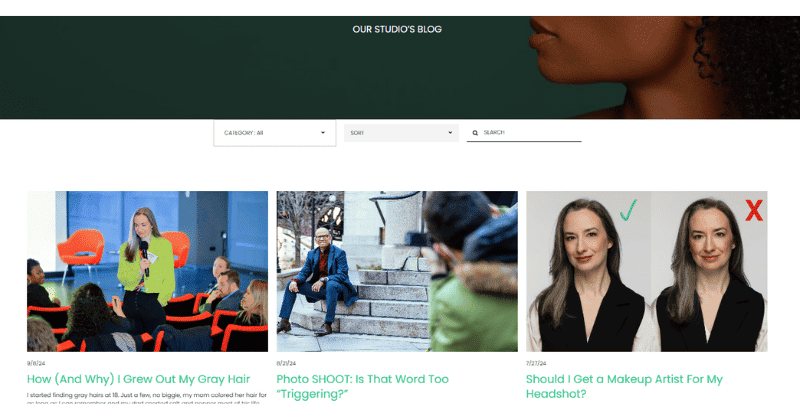

11. Promote Your Services Through Social Media Marketing:
Social media is your digital gallery and marketing engine. Social media platforms like Instagram, Facebook, and TikTok are gold mines for photographers. Consistently share social media posts of your best work, actively engage with your audience, and use relevant hashtags to boost visibility. Photography marketing thrives on these platforms by leveraging visuals that captivate potential clients and tell your brand’s story.


Don’t just post photos—show behind-the-scenes content, and client stories, and even offer tips. Social media marketing is about building relationships, not just booking clients. The more authentic you are, the more likely people will trust you.


12. Leverage Pinterest for Visual Inspiration and Exposure:
Pinterest is a visual search engine, making it perfect for photographers. Create boards that showcase your portfolio, inspiration, and even photography tips. Every image you post can link back to your website, driving traffic and potential clients.
Pinterest also has a long content lifespan, meaning your posts can be discovered months or even years later. Optimize your pins with relevant keywords and catchy titles. It’s a hidden gem in photography marketing that many overlook.


13. Build Relationships with Email Marketing Campaigns:
Email marketing is one of the most direct ways to reach your audience. Build an email list by offering free guides, discounts, or exclusive content. Send regular newsletters showcasing your recent work, promotions, or blog posts. Incorporating photography marketing into your emails with stunning visuals can make your content more compelling and increase engagement.
Personalize your emails to make them feel more engaging. Email marketing is about nurturing relationships over time. A well-timed email can remind a potential client to book with you, especially when combined with a special offer.
Pro Tip:
Utilize Systeme.io’s email marketing tools to create targeted email campaigns that nurture leads, promote special offers, and keep potential clients engaged with your photography services.
14. Optimize for Local SEO with Google Business Profile:
Local SEO helps you dominate your area. Start by claiming your Google Business Profile, filling out all the details, and adding high-quality images. Ask past clients to leave reviews, and regularly update your profile with fresh content.
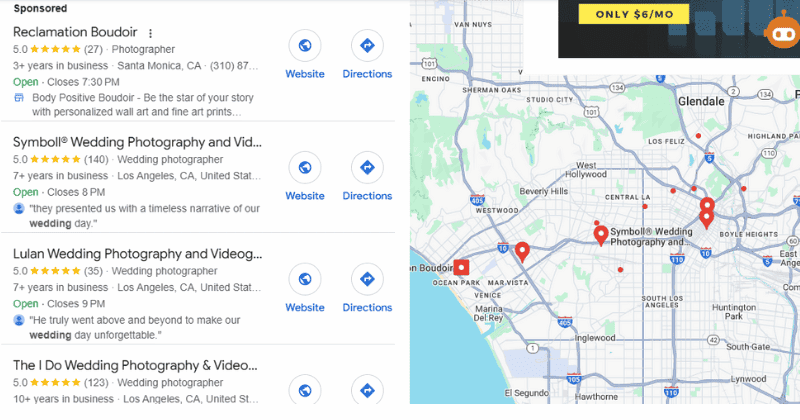

Local SEO makes sure that when people search for “photographer near me,” you show up. Combine this with blog posts and website optimization to cover all your search engine bases. Your goal is to own your local market.
15. Utilize Pay-Per-Click (PPC) and Google Ads:
PPC ads get you in front of potential clients instantly. Create ads targeting specific keywords like “engagement photographer” or “corporate headshots” and set a budget. Google Ads and Facebook Ads allow you to target by location, age, and interests, making your marketing highly focused. Photography marketing benefits from using captivating images in these ads, as strong visuals can grab attention and boost click-through rates.
The key is to write compelling ad copy and use strong visuals. PPC can be a game-changer if you need immediate traffic and bookings.


16. Create High-Converting Sales Funnels for Leads:
A sales funnel is a step-by-step process that turns website visitors into paying clients. It starts with awareness, moves to interest, and ends with a booking. Offer something free, like a guide or consultation, in exchange for an email address.
Then, nurture those leads with email campaigns until they’re ready to hire you. A well-structured funnel can automate a lot of your marketing efforts, making it easier to focus on what you do best—photography.
Learn how a sales funnel operates, how it can significantly amplify your photography business, and the crucial steps to creating an automated, high-converting funnel that streamlines client acquisition and drives outstanding results.
Pro Tip:
Build high-converting sales funnels with Systeme.io to guide prospects from inquiry to booking, using automated sequences to nurture and convert leads efficiently.
Master the art of funnel-building with Systeme.io! Enroll in our FREE Systeme.io Funnel Builder Certification Course and discover powerful strategies to elevate your photography business, boosting both growth and profitability.
17. Boost Visibility with Social Media Advertising:
Social media ads can be hyper-targeted to your ideal clients. Whether it’s Facebook, Instagram, or Pinterest, you can set parameters like age, location, and interests to reach the right audience. Use eye-catching visuals, a strong call-to-action, and clear ad copy. Photography marketing thrives in this space, as compelling images can draw potential clients in and showcase your unique style.
Experiment with different formats, like carousel ads or video ads. The more targeted your ad is, the higher your chances of converting leads into clients.
18. Maximize Reach with Google Local Service Ads
Google Local Service Ads are designed to help local businesses get found quickly. These ads appear at the top of Google search results, and you only pay when someone contacts you. Your profile should be complete and your reviews are stellar, as they impact your ranking.
Local Service Ads are perfect for photographers looking to dominate their area and get more inquiries. Combine this with strong local SEO, and you’ll own your market.
19. Create Optimized, Lead-Generating Landing Pages:
A landing page is where visitors end up after clicking on an ad or link. Ensure your landing pages are optimized for conversions with clear headlines, strong calls to action, and minimal distractions. Photography marketing can significantly enhance your landing pages by incorporating stunning visuals that showcase your work and resonate with your target audience.
Use testimonials and high-quality images to build trust. The goal is to turn visitors into clients or at least capture their email addresses for future marketing efforts. Test different layouts and copy to see what works best.
Supercharge your photography business with ease! Check out our in-depth guide on crafting a high-converting Systeme.io landing page that captures more leads and fuels your business growth.
Pro Tip:
Design an optimized landing page with Systeme.io that highlights your photography packages, testimonials, and portfolio, encouraging visitors to book a session or request more information.


20. Incorporate QR Codes into Your Marketing Materials:
QR codes are making a comeback, and they’re a simple way to bridge the gap between offline and online marketing. Add QR codes to your business cards, flyers, or even your prints. When scanned, these codes can lead people to your website, portfolio, or booking page.
It’s a quick and easy way to drive traffic and capture leads. In a world where convenience is king, QR codes are a smart addition to your **photography marketing** toolkit.
21. Offer Membership Content:
Memberships create recurring revenue and keep clients engaged long-term. Offer exclusive content, behind-the-scenes footage, or premium tutorials through a membership platform like Systeme.io. Memberships add value for clients who want more than just a one-off session.
It’s a great way to build a loyal community while generating a steady income. By giving members something they can’t get anywhere else, you create a stronger bond with your audience.
Pro Tip:
Create a membership site with Systeme.io to offer exclusive photography content, tutorials, or digital downloads to clients and photography enthusiasts, generating recurring revenue.
22. Set Up an Affiliate Program to Expand Your Reach:
Affiliate programs incentivize others to promote your business. Offer a commission for every client referred by an affiliate, and watch your reach expand exponentially. Choose affiliates that align with your brand, like event planners or makeup artists, who can refer clients directly to you.
Affiliates help you tap into networks you wouldn’t otherwise reach. It’s like building a sales force without the overhead costs.
Pro Tip:
Set up an affiliate program through Systeme.io to encourage satisfied clients and influencers to promote your photography services in exchange for commissions.


C. Explore Innovative Marketing For Photographers:
23. Offer Virtual Tours and 360° Photography Services:
Virtual tours and 360° photos are becoming increasingly popular, especially for real estate and commercial clients. Offering these services sets you apart from other professional photographers. Invest in the right equipment and learn the technical skills to deliver high-quality results. Photography marketing can effectively highlight these unique offerings, attracting clients who are looking for innovative ways to showcase their properties.
Virtual tours are especially valuable for clients who want to showcase spaces remotely, like realtors or hotel owners. Not only do these services add value to your portfolio, but they also command higher fees.
24. Host Educational Webinars to Teach Photography:
Webinars position you as an expert in your field. Share your knowledge about photography techniques, gear, or even business tips. Hosting free webinars is a great way to build your email list and nurture potential photography clients.
You can also offer paid webinars for more in-depth content. Webinars allow you to connect with a larger audience and showcase your expertise. Plus, they’re a great way to build trust before someone books a session.
Pro Tip:
Create and host webinars via Systeme.io to showcase your photography expertise, engage with potential clients, and educate them on photography-related topics, driving interest in your services. This feature is available on the Webinar and Unlimited Plan.
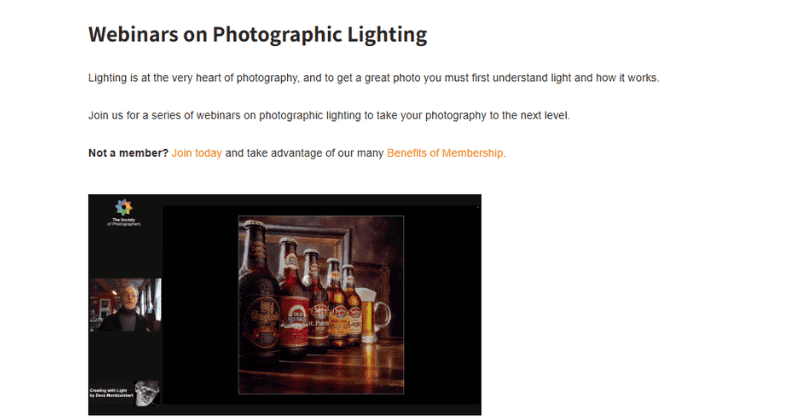

25. Engage Clients with a Chatbot on Your Website:
A chatbot is like having a 24/7 customer service rep on your website. It can answer basic questions, collect email addresses, and guide visitors to the right pages. Setting up a chatbot improves user experience and ensures you never miss an inquiry.
It also saves you time by automating responses to frequently asked questions. Use it to capture leads and schedule consultations without lifting a finger. In today’s digital world, chatbots are a no-brainer.
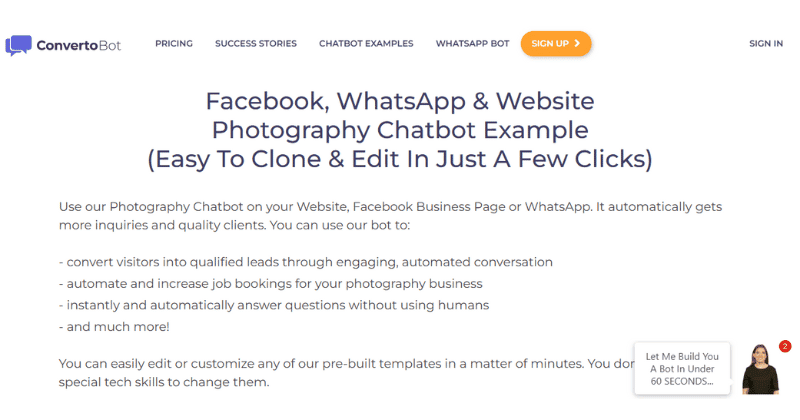

26. Increase Visibility by Guesting on Podcasts:
Podcasts are a great platform to share your story and expertise. Reach out to podcast hosts in the photography, business, or creative spaces and offer to be a guest. It’s free exposure to an audience that’s already interested in what you do.
Share your journey, photography tips, or marketing advice, and drive listeners to your website or social media. Being a podcast guest also positions you as an expert in your niche, building credibility and trust.


27. Create and Sell Online Photography Courses:
If you’ve mastered photography, why not teach it? Creating online courses not only generates passive income but also positions you as an authority in the industry. Platforms like Teachable or Systeme.io make it easy to host and sell courses. Photography marketing can play a crucial role in promoting these courses, helping you reach potential students through targeted campaigns and engaging content.
Whether you teach basic photography skills or advanced techniques, there’s a market for it. Online courses allow you to reach a global audience while monetizing your expertise.
Pro Tip:
Use Systeme.io to create and sell online photography courses, providing educational content to aspiring photographers or clients while generating additional income for your business.


28. Host Livestreams to Showcase Your Work in Real-Time:
Live streaming allows you to connect with your audience in real-time. Whether it’s a behind-the-scenes look at a photo shoot or a live Q&A, livestreams build engagement. Platforms like Instagram and YouTube make it easy to go live and interact with viewers.
Use this as an opportunity to showcase your personality and expertise. The more people get to know you, the more likely they are to hire you. It’s a simple way to build community and trust.
29. Collaborate on Projects with Industry Partners:
Collaboration is a powerful way to expand your network and reach new audiences. Partner with makeup artists, event planners, wedding planners, or venues to create joint projects.
For example, you could offer a package deal for a wedding that includes photography, makeup, and venue discounts. This not only adds value for clients but also exposes your brand to your partner’s audience. Win-win.
Explore our comprehensive article on Wedding Planner Marketing Ideas, packed with creative insights and proven strategies to ignite new inspiration for growing your photography business.
30. Run Photo Contests to Engage Your Audience:
Contests are a fun way to engage your audience and grow your following. Host a photo contest where participants submit their best shots, and the winner gets a free session or print. Promote the contest on social media, encouraging followers to share and tag friends.
Contests generate buzz, increase brand awareness, and give you a chance to connect with new potential clients. Plus, they’re a great way to gather user-generated content.
D. Traditional Photography Marketing Ideas:
31. Launch Targeted Direct Mail Campaigns:
Direct mail isn’t dead—it’s just evolved. Send beautifully designed postcards or brochures to a targeted list of potential clients in your area. Make sure your message is clear, your design is eye-catching, and you include a strong call-to-action, like a discount or free consultation.
Direct mail stands out in a world full of digital ads. People still appreciate something tangible, and it gives you another touchpoint to connect with local clients.
32. Distribute Flyers and Brochures Locally:
Sometimes the simplest methods are the most effective. Design flyers and brochures that showcase your best work and contact details, then distribute them locally. Focus on areas where your ideal clients are likely to be, like coffee shops, coworking spaces, or local events.
The key is to make sure your materials look professional and include a compelling offer. Flyers are especially effective for event photographers looking to get booked for local gigs.
33. Design Eye-Catching Business Cards:
Business cards are still one of the most powerful networking tools. A well-designed card can leave a lasting impression long after your initial meeting. Include your name, title, contact info, website, and a professional image.
Hand them out at events, leave them at local businesses, and always have a few on you. Your business card is a physical reminder of your brand. Make it count.
34. Invest in Local Print Advertising:
Local magazines, newspapers, or event programs are great places to advertise your photography services. Print ads can be highly targeted to your community and offer a level of credibility that digital ads sometimes lack. Your ad should include a clear call to action and highlight your niche.
Local print advertising is especially effective for event and portrait photographers who want to build a strong local presence.
35. Offer Seasonal Promotions to Drive Sales:
Seasonal promotions are a great way to create urgency and drive bookings. Offer discounts during the holidays, back-to-school season, or wedding season. Promote these offers through your website, email list, and social media.
Limited-time offers create a sense of urgency, motivating potential clients to book sooner rather than later. Seasonal promotions can also help you fill up slower periods in your calendar.
E. Build Partnerships and Engage with the Community:
36. Form Strategic Partnerships with Local Businesses
Partnering with local businesses is a win-win. For example, if you’re a wedding photographer, team up with local florists, bakers, or venues. You can refer clients to each other and even create joint marketing campaigns.
Collaborations like these expand your network and expose you to prospective patrons you wouldn’t have reached otherwise. Local partnerships strengthen your presence in the community, leading to more opportunities and bookings.
37. Collaborate with Local Influencers to Boost Exposure:
Influencers aren’t just for big brands. Local influencers with engaged followings can help you get in front of the right audience. Offer them a free photoshoot in exchange for promoting your work on their social media channel. Influencers can reach prospective clients who trust their recommendations.
It’s a cost-effective way to boost your visibility and grow your client base. Choose influencers who align with your brand for the best results.
38. Participate in Local Events to Promote Your Brand:
Local events are goldmines for photographers. Whether it’s a wedding expo, farmer’s market, or charity gala, these gatherings are filled with potential customers. Set up a booth, showcase your portfolio, and engage with attendees.
Offer special event-only discounts to encourage bookings. The key is to be approachable and professional—people are more likely to remember you if they’ve had a personal interaction.
39. Host Photography Workshops to Educate and Connect:
Workshops are a great way to showcase your expertise and build relationships with potential clients. Host beginner photography classes or advanced workshops for those looking to improve their skills. Not only will you position yourself as an authority, but you’ll also create a new revenue stream.
Workshops offer a personal touch, allowing attendees to experience your teaching style and personality first-hand. It’s a great way to connect with your community.
40. Offer Sponsorships for Local Charity Events:
Sponsoring a local charity event is a great way to give back while promoting your brand. Offer to cover the event and donate a portion of your fees to the cause. This not only helps the community but also boosts your visibility and credibility.
People appreciate businesses that give back, and it’s a great way to build goodwill. Plus, you’ll have the opportunity to network with potential clients who share similar values.
Wrap Up:
The photography business is competitive, but with the right marketing strategies, you can set yourself apart. Whether you’re leveraging innovative techniques like virtual tours and chatbots or sticking with tried-and-true tactics like direct mail and business cards, each of these photography marketing ideas can help you grow your small business.
The key is to find what resonates with your audience and stay consistent. By implementing these strategies, you’ll position yourself as a top choice in your market and attract the clients you want. Now, it’s time to take action and elevate your photography business to the next level.
Hey shutterbug! Imagine having a powerful tool that takes care of all your marketing needs—websites, emails, funnels, and more—without any tech stress. With Systeme.io’s FREE plan, you can streamline your workflow, attract more clients, and focus on what you do best: capturing stunning photos! Want to fill your calendar faster and with less effort? Get started for free and watch your photography business soar to new heights. Don’t miss out—sign up now and take your business to the next level with zero cost and endless possibilities!
🎉 Ready to supercharge your photography business? For a limited time, unlock all of Systeme.io’s premium features with an exclusive 40% discount! 🚀 Picture this: advanced tools to build breathtaking websites, create high-converting funnels, and automate your email campaigns—all designed to fuel your growth and help you book more clients effortlessly. If you’re ready to elevate your business and fast-track your success, now’s the perfect time to grab the premium plan at a fraction of the cost. This special offer won’t last long! 🎯 Claim your 40% discount today and watch your photography empire flourish! 📸










I like this website because so much useful stuff on here : D.